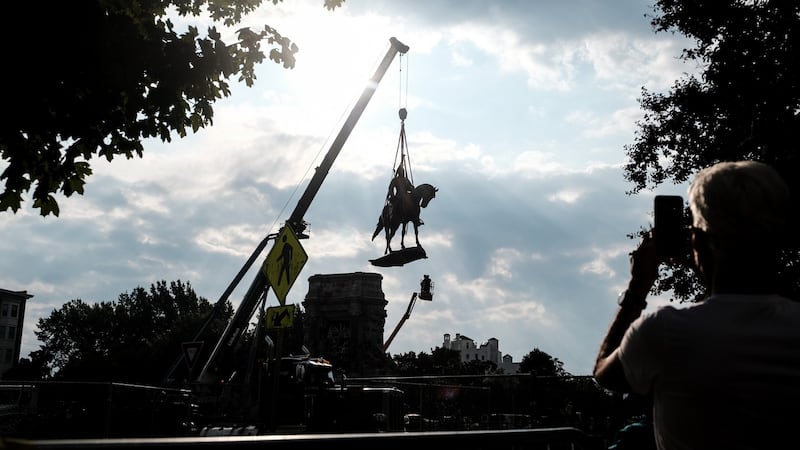After more than a year of legal wrangling, one of the largest Confederate monuments in the US – a soaring statue of Robert E Lee, the South's civil war general – was hoisted off its pedestal in downtown Richmond, Virginia, on Wednesday morning.
The Lee statue was erected in 1890, the first of six Confederate monuments – symbols of white power that dotted the main boulevard in Richmond, the former capital of the Confederacy. On Wednesday, it was the last of them to be removed, opening up the story of this city to all of its residents to write.
"This city belongs to all of us, not just some of us," said David Bailey, who is black and whose nonprofit organisation, Arrabon, helps churches with racial reconciliation work. "Now we can try to figure out what's next. We are creating a new legacy."
The country has periodically wrestled with monuments to its Confederate past, including in 2017, after a far-right rally in Charlottesville, Virginia, touched off efforts to tear them down – and to put them up. Richmond, too, removed some after the murder of George Floyd last year, in a sudden operation that took many by surprise. But the statue of Lee endured, mostly because of its complicated legal status.
That was clarified last week by the supreme court of Virginia. On Monday, governor Ralph Northam, who had called for its removal last year, announced he would finally do it.
Its removal marked the end of the era of Confederate monuments in the city that is perhaps best known for them. Monument Avenue, the grassy boulevard where many of them stood, was a proud feature of the city’s architecture and a coveted address.
Diverse
But in recent years, as the city became more diverse, demographically and politically, more of its residents began to question the memorials. Now, as the last statue is taken down, many people interviewed in this once conservative southern city said that they might not have agreed in past years, but that now their removal felt right.
"I've evolved," said Irv Cantor, a moderate Democrat in Richmond, who is white and whose house is on Monument Avenue. "I was naively thinking that we could keep these statues and just add new ones to show the true history and everything would be fine."
But he said the past few years of momentous events involving race, from the election of the first black president, to the violence in Charlottesville in 2017, to the killing of Mr Floyd last summer and the protests that followed, showed him that the monuments were fundamentally in conflict with fairness in the US.
“Now I understand the resentment that folks have toward these monuments,” said Mr Cantor (68). “I don’t think they can exist anymore.”

Perhaps no city better represents the US’s messy moment on race than Richmond. It is marked by profound racial inequalities, the result of generations of discrimination, in which black residents’ votes were diluted and black homeowners could not get loans. But decades of reconciliation work going back to the 1990s made the city more receptive than many in the South to removing its Confederate monuments, those who did the work argued.
Pushback
"Richmond has come a long way," said Rev Sylvester Turner, pastor at Pilgrim Baptist Church in the Richmond neighbourhood of East View, who has worked on racial reconciliation in the city for 30 years. "We've begun to peel back the scabs. When you do that, you experience a lot of pain and a lot of pushback, and I think we are in that place. We are dealing with a lot of the unhealed wounds that are beneath the surface."
Even so, the monuments were at the heart of Richmond’s identity and were backed by powerful residents, and the fact that they came down seemed to surprise almost everybody.
“If you would have told me that the monuments were going to go down, I would have thought somebody would blow up Richmond first before anyone would have let that happen,” Mr Bailey said. “I think it’s a modern-day miracle.”
What is left is a city littered with empty pedestals, a kind of symbol of the US's unfinished business of race that is particularly characteristic of Richmond. That landscape – and the political upheaval that has come with it – has brought a backlash too. – This article originally appeared in The New York Times











